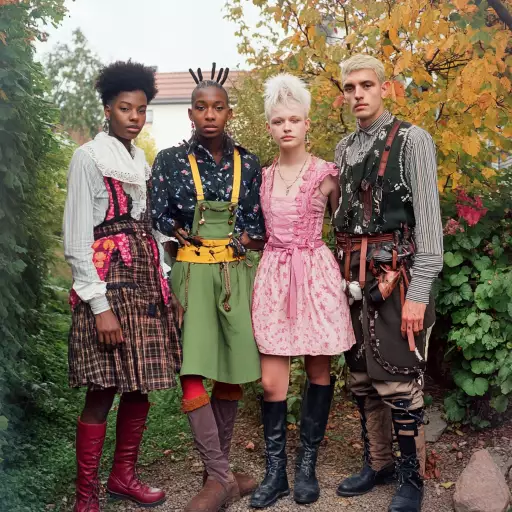Explore the Best AI Image Gallery

Quantum Leaps in Creativity: How Quantum Computing is Reshaping the Arts
The world of art has always been a playground for innovation, constantly pushing boundaries and exploring new frontiers. Now, a new force is poised to revolutionize creative expression: quantum computing.
Beyond its potential to crack complex codes and accelerate scientific discovery, quantum computing offers a unique set of capabilities that can unlock unprecedented levels of creativity. From generating mesmerizing new art forms to empowering artists with innovative tools, the impact of this technology on the creative industry is profound and multifaceted.
Quantum Creativity: A New Artistic Language
Imagine an artist who can design intricate patterns based on complex mathematical equations, or a musician who can compose symphonies guided by quantum algorithms. This is the realm of possibilities that quantum computing unlocks.
By harnessing the power of superposition and entanglement, quantum computers can explore vast landscapes of creative ideas with unprecedented speed and precision. Artists can leverage these capabilities to:
- Generate unique and intricate visual designs based on complex data sets.
- Compose music with novel harmonies and rhythms, exploring uncharted sonic territories.
- Craft interactive installations that respond dynamically to viewer input, blurring the lines between art and technology.
Tools for Artistic Empowerment
Quantum computing isnt just about generating art; its also about empowering artists with new tools and techniques.
Here are some ways quantum-powered tools can revolutionize the creative process:
- Enhanced Design Software: Imagine design programs that utilize quantum algorithms to optimize shapes, textures, and patterns, pushing the boundaries of aesthetic innovation.
- Personalized Creative Experiences: Quantum computing could enable personalized art experiences tailored to individual preferences and emotions, creating truly immersive and engaging works.
- Collaborative Creativity on a New Scale: Artists from around the world can collaborate in real-time on quantum-powered platforms, sharing ideas and co-creating masterpieces with unprecedented ease.
Navigating the Ethical Landscape
As with any powerful technology, quantum computing raises important ethical considerations for the creative industry:
- Ownership and Copyright: Who owns the copyright to artwork generated by quantum algorithms? This question demands careful consideration and legal frameworks that reflect the unique nature of quantum-created art.
- Bias and Representation: Quantum algorithms are trained on data, and if this data reflects existing biases, it can perpetuate them in the creative output. It is crucial to ensure fairness and inclusivity in the development and deployment of quantum-powered art tools.
- Accessibility and Equity: Access to quantum computing resources should be equitable, ensuring that all artists, regardless of their background or resources, have the opportunity to benefit from this transformative technology.
The Future of Quantum Creativity
The fusion of quantum computing and the creative arts is still in its nascent stages, but the potential is truly awe-inspiring.
As research progresses and quantum technologies become more accessible, we can expect to see:
- Emergence of New Art Forms: Quantum computing will undoubtedly give rise to entirely new genres of art, pushing the boundaries of human imagination and expression.
- Increased Collaboration Between Artists and Scientists: A deeper partnership between artists and quantum researchers will foster innovative creative solutions and accelerate the development of quantum-powered art tools.
- Quantum Art as a Mainstream Phenomenon: Quantum-created art may soon become commonplace, integrated into museums, galleries, and even everyday life.
The journey into the world of quantum creativity is just beginning. As we explore this uncharted territory, we can expect to witness groundbreaking innovations, artistic breakthroughs, and a profound shift in how we understand and experience the creative process.



](https://images.ai-img.art/thumbnails/150/f67d9af3398150f2ab1bcf250717fea134275e2ca896252b54a4d9bb3719f9ac.webp)







](https://images.ai-img.art/thumbnails/150/f9584153b4cddd8c9fab611dc10247549b275c59bc173251e37d0935874f9deb.webp)





](https://images.ai-img.art/thumbnails/150/c2c9c48b38fae37f0a457b80b084ed01ba803810fc8f488c8f610c03abc74049.webp)
















](https://images.ai-img.art/thumbnails/150/bddf3ae4a232290858389b933c866ad3be429ef2e25c23a9f4d7713ed6e44d0b.webp)
](https://images.ai-img.art/thumbnails/150/008b5d5d49667cc2e93a5f8a8adfaa545963da99c39ff0901f5296294636400d.webp)
](https://images.ai-img.art/thumbnails/150/4289d1230b86a96c4d556636c3167bed0ef38f850826549517e4e45db4d87bf7.webp)




